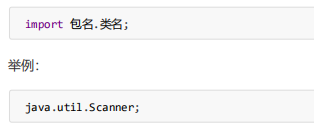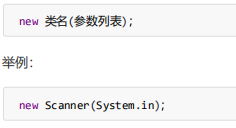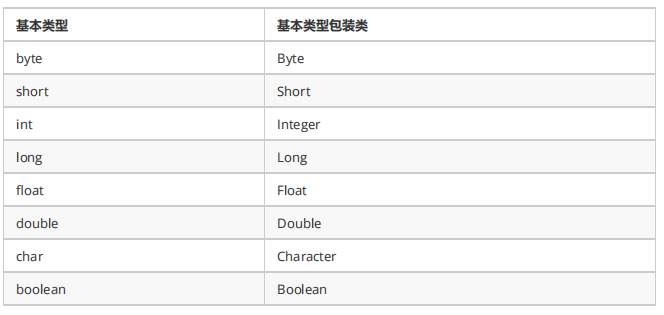API
概述
API(Application Programming Interface),应用程序编程接口。Java API是一本程序员的 字典 ,是JDK中提供给我们使用的类的说明文档。这些类将底层的代码实现封装了起来,我们不需要关心这些类是如何实现的,只需要学习这些类如何使用即可。所以我们可以通过查询API的方式,来学习Java提供的类,并得知如何使用它们。
API使用步骤
- 打开帮助文档。
- 点击显示,找到索引,看到输入框。
- 你要找谁?在输入框里输入,然后回车。
- 看包。java.lang下的类不需要导包,其他需要。
- 看类的解释和说明。
- 学习构造方法
- 使用成员方法/变量
引用类型使用步骤
类属于引用类型中的一种,所以去使用步骤符合引用类型的使用步骤。
1:导包
使用import关键字导包,在类的所有代码之前导包,引入要使用的类型,java.lang包下的所有类无需导入。
格式:

2:创建对象
使用该类的构造方法,创建一个该类的对象。 格式:

3:调用方法
调用该类的成员方法,完成指定功能。 格式:

// 接收一个键盘录入的整数 int i = sc.nextInt();
Scanner类
Scanner使用步骤
查看类
- java.util.Scanner :该类需要import导入后使用。
查看构造方法
- public Scanner(InputStream source) : 构造一个新的 Scanner ,它生成的值是从指定的输入流扫描的。
查看成员方法
- public int nextInt() :将输入信息的下一个标记扫描为一个 int 值。
- public String next():将输入信息的下一个标记扫描为一个 String值。
举例
package demo01; import java.util.Scanner; // 1. 导包 /* Scanner类的功能:可以实现键盘输入数据,到程序当中。 获取键盘输入的一个int数字:int num = sc.nextInt(); 获取键盘输入的一个字符串:String str = sc.next(); */ public class Demo01Scanner { public static void main(String[] args) { // 2. 创建 // 备注:System.in代表从键盘进行输入 Scanner sc = new Scanner(System.in); // 3. 获取键盘输入的int数字 int num = sc.nextInt(); System.out.println("输入的int数字是:" + num); // 4. 获取键盘输入的字符串 String str = sc.next(); System.out.println("输入的字符串是:" + str); } }
使用Scanner类,完成接收键盘录入三个数据并获取最大值,代码如下
package demo01; import java.util.Scanner; /* 题目: 键盘输入三个int数字,然后求出其中的最大值。 思路: 1. 既然是键盘输入,肯定需要用到Scanner 2. Scanner三个步骤:导包、创建、使用nextInt()方法 3. 既然是三个数字,那么调用三次nextInt()方法,得到三个int变量 4. 无法同时判断三个数字谁最大,应该转换成为两个步骤: 4.1 首先判断前两个当中谁最大,拿到前两个的最大值 4.2 拿着前两个中的最大值,再和第三个数字比较,得到三个数字当中的最大值 5. 打印最终结果 */ public class Demo03ScannerMax { public static void main(String[] args) { Scanner sc = new Scanner(System.in); System.out.println("请输入第一个数字:"); int a = sc.nextInt(); System.out.println("请输入第二个数字:"); int b = sc.nextInt(); System.out.println("请输入第三个数字:"); int c = sc.nextInt(); // 首先得到前两个数字当中的最大值 int temp = a > b ? a : b; int max = temp > c ? temp : c; System.out.println("最大值是:" + max); } }
匿名对象
概念
创建对象时,只有创建对象的语句,却没有把对象地址值赋值给某个变量。虽然是创建对象的简化写法,但是应用场景非常有限。匿名对象 :没有变量名的对象。
格式:

应用场景
- 创建匿名对象直接调用方法,没有变量名。
new Scanner(System.in).nextInt();
- 匿名对象可以作为方法的参数
public class Demo01Anonymous { public static void main(String[] args) { /* 普通方式 Scanner sc = new Scanner(System.in); input(sc); */ //匿名对象作为方法接收的参数 input(new Scanner(System.in)); } public static void input(Scanner sc) { System.out.println(sc); } }
- 匿名对象可以作为方法的返回值
public class Demo01Anonymous { public static void main(String[] args) { Scanner sc = getScanner(); } public static Scanner getScanner() { /*普通方式 Scanner sc = new Scanner(System.in); return sc; */ //匿名对象作为方法返回值 return new Scanner(System.in); } }
注意事项:
- 匿名对象只能使用唯一的一次,下次再用不得不再创建一个新对象。
使用建议:
- 如果确定有一个对象只需要使用唯一的一次,就可以用匿名对象。
Random类
此类的实例用于生成伪随机数。例如,以下代码使用户能够得到一个随机数:
Random r = new Random(); int i = r.nextInt();
Random使用步骤
查看类
- java.util.Random :该类需要 import导入使后使用。
查看构造方法
- public Random() :创建一个新的随机数生成器。
查看成员方法
- public int nextInt(int n) :返回一个伪随机数,范围在 0 (包括)和 指定值 n (不包括)之间的int 值。
- public int nextInt( ) :返回一个伪随机数,范围是int所有范围,有正负两种。
举例
获取1-n之间的随机数,包含n,代码如下:
package demo03; import java.util.Random; /* 思路: 1. 定义一个int变量n,随意赋值 2. 要使用Random:三个步骤,导包、创建、使用 3. 如果写10,那么就是0~9,然而想要的是1~10,可以发现:整体+1即可。 4. 打印随机数字 */ public class Demo03Random { public static void main(String[] args) { int n = 5; Random r = new Random(); for (int i = 0; i < 100; i++) { // 本来范围是[0,n),整体+1之后变成了[1,n+1),也就是[1,n] int result = r.nextInt(n) + 1; System.out.println(result); } } }
题目:
用代码模拟猜数字的小游戏。
package demo03; import java.util.Random; import java.util.Scanner; /* 思路: 1. 首先需要产生一个随机数字,并且一旦产生不再变化。用Random的nextInt方法 2. 需要键盘输入,所以用到了Scanner 3. 获取键盘输入的数字,用Scanner当中的nextInt方法 4. 已经得到了两个数字,判断(if)一下: 如果太大了,提示太大,并且重试; 如果太小了,提示太小,并且重试; 如果猜中了,游戏结束。 5. 重试就是再来一次,循环次数不确定,用while(true)。 */ public class Demo04RandomGame { public static void main(String[] args) { Random r = new Random(); int randomNum = r.nextInt(100) + 1; // [1,100] Scanner sc = new Scanner(System.in); while (true) { System.out.println("请输入你猜测的数字:"); int guessNum = sc.nextInt(); // 键盘输入猜测的数字 if (guessNum > randomNum) { System.out.println("太大了,请重试。"); } else if (guessNum < randomNum) { System.out.println("太小了,请重试。"); } else { System.out.println("恭喜你,猜中啦!"); break; // 如果猜中,不再重试 } } System.out.println("游戏结束。"); } }
ArrayList类
到目前为止,我们想存储对象数据,选择的容器,只有对象数组。而数组的长度是固定的,无法适应数据变化的需求。为了解决这个问题,Java提供了另一个容器 java.util.ArrayList 集合类,让我们可以更便捷的存储和操作对象数据
什么是ArrayList类
java.util.ArrayList 是大小可变的数组的实现,存储在内的数据称为元素。此类提供一些方法来操作内部存储的元素。 ArrayList 中可不断添加元素,其大小也自动增长。
ArrayList使用步骤
查看类
- java.util.ArrayList <E> :该类需要 import导入使后使用。<E> ,表示一种指定的数据类型,叫做泛型。 E ,取自Element(元素)的首字母。在出现 E 的地方,我们使用一种引用数据类型将其替换即可,表示我们将存储哪种引用类型的元素。代码如下:
//泛型为String ArrayList<String> //泛型为Student ArrayList<Student>
查看构造方法
- public ArrayList() :构造一个内容为空的集合。
基本格式:

常用方法和遍历
对于元素的操作,基本体现在——增、删、查。常用的方法有:
- public boolean add(E e) :将指定的元素添加到此集合的尾部。
- public E remove(int index) :移除此集合中指定位置上的元素。返回被删除的元素。
- public E get(int index) :返回此集合中指定位置上的元素。返回获取的元素。
- public int size() :返回此集合中的元素数。遍历集合时,可以控制索引范围,防止越界。
举例:
package demo04; import java.util.ArrayList; /* 数组的长度不可以发生改变。 但是ArrayList集合的长度是可以随意变化的。 对于ArrayList来说,有一个尖括号<E>代表泛型。 泛型:也就是装在集合当中的所有元素,全都是统一的什么类型。 注意:泛型只能是引用类型,不能是基本类型。 */ public class Demo03ArrayListMethod { public static void main(String[] args) { //创建arrayList集合,泛型为String ArrayList<String> list = new ArrayList<>(); //对于ArrayList集合来说,直接打印得到的不是地址值,而是内容。如果内容是空,得到的是空的中括号:[] System.out.println(list); // [] /* public boolean add(E e):向集合当中添加元素,参数的类型和泛型一致。返回值代表添加是否成功。 备注:对于ArrayList集合来说,add添加动作一定是成功的,所以返回值可用可不用。 但是对于其他集合(今后学习)来说,add添加动作不一定成功。 */ boolean success = list.add("柳岩"); System.out.println(list); // [柳岩] System.out.println("添加的动作是否成功:" + success); //添加的动作是否成功:true list.add("高圆圆"); list.add("赵又廷"); list.add("李小璐"); list.add("贾乃亮"); System.out.println(list); // [柳岩, 高圆圆, 赵又廷, 李小璐, 贾乃亮] //E get(int index):从集合当中获取元素,参数是索引编号,返回值就是对应位置的元素。 String name = list.get(2); System.out.println("第2号索引位置:" + name); // 第2号索引位置:赵又廷 // E remove(int index):从集合当中删除元素,参数是索引编号,返回值就是被删除掉的元素。 String whoRemoved = list.remove(3); System.out.println("被删除的人是:" + whoRemoved); // 被删除的人是:李小璐 System.out.println(list); // [柳岩, 高圆圆, 赵又廷, 贾乃亮] // int size():获取集合的尺寸长度,返回值是集合中包含的元素个数。 int size = list.size(); System.out.println("集合的长度是:" + size);//集合的长度是:4 } }
遍历集合
import java.util.ArrayList; public class Demo04ArrayListEach { public static void main(String[] args) { ArrayList<String> list = new ArrayList<>(); list.add("迪丽热巴"); list.add("古力娜扎"); list.add("玛尔扎哈"); // 遍历集合 for (int i = 0; i < list.size(); i++) { System.out.println(list.get(i)); } } }
如何存储基本数据类型
ArrayList对象不能存储基本类型,只能存储引用类型的数据。类似 <int> 不能写,但是存储基本数据类型对应的包装类型是可以的。所以,想要存储基本类型数据, <> 中的数据类型,必须转换后才能编写,转换写法如下:

从JDK 1.5+开始,支持自动装箱、自动拆箱。
- 自动装箱:基本类型 --> 包装类型
- 自动拆箱:包装类型 --> 基本类型
我们发现,只有 Integer 和 Character 需要特殊记忆,其他基本类型只是首字母大写即可。那么存储基本类型数据,代码如下
package demo04; import java.util.ArrayList; /* 如果希望向集合ArrayList当中存储基本类型数据,必须使用基本类型对应的“包装类”。 基本类型 包装类(引用类型,包装类都位于java.lang包下) byte Byte short Short int Integer 【特殊】 long Long float Float double Double char Character 【特殊】 boolean Boolean */ public class Demo05ArrayListBasic { public static void main(String[] args) { ArrayList<String> listA = new ArrayList<>(); // ArrayList<int> listB = new ArrayList<>();错误写法!泛型只能是引用类型,不能是基本类型 ArrayList<Integer> listC = new ArrayList<>(); //自动装箱:基本类型 --> 包装类型 listC.add(100); listC.add(200); System.out.println(listC); // [100, 200] //自动拆箱:包装类型 --> 基本类型 int num = listC.get(1); System.out.println("第1号元素是:" + num);//第1号元素是:200 } }
需求
生成6个1~33之间的随机整数,添加到集合,并遍历集合。
代码实现
package cn.itcast.day07.demo05; import java.util.ArrayList; import java.util.Random; /* 思路: 1. 需要存储6个数字,创建一个集合,<Integer> 2. 产生随机数,需要用到Random 3. 用循环6次,来产生6个随机数字:for循环 4. 循环内调用r.nextInt(int n),参数是33,0~32,整体+1才是1~33 5. 把数字添加到集合中:add 6. 遍历集合:for、size、get */ public class Demo01ArrayListRandom { public static void main(String[] args) { ArrayList<Integer> list = new ArrayList<>(); Random r = new Random(); for (int i = 0; i < 6; i++) { int num = r.nextInt(33) + 1; list.add(num); } // 遍历集合 for (int i = 0; i < list.size(); i++) { System.out.println(list.get(i)); } } }
需求
自定义4个学生对象,添加到集合,并遍历。
定义student类
package demo04; public class Student { private String name; private int age; public Student() { } public Student(String name, int age) { this.name = name; this.age = age; } public String getName() { return name; } public void setName(String name) { this.name = name; } public int getAge() { return age; } public void setAge(int age) { this.age = age; } }
添加到集合中
package demo04; import java.util.ArrayList; /* 思路: 1. 自定义Student学生类,四个部分。 2. 创建一个集合,用来存储学生对象。泛型:<Student> 3. 根据类,创建4个学生对象。 4. 将4个学生对象添加到集合中:add 5. 遍历集合:for、size、get */ public class Demo02ArrayListStudent { public static void main(String[] args) { ArrayList<Student> list = new ArrayList<>(); Student one = new Student("洪七公", 20); Student two = new Student("欧阳锋", 21); Student three = new Student("黄药师", 22); Student four = new Student("段智兴", 23); list.add(one); list.add(two); list.add(three); list.add(four); // 遍历集合 for (int i = 0; i < list.size(); i++) { Student stu = list.get(i); System.out.println("姓名:" + stu.getName() + ",年龄" + stu.getAge()); } } }
需求
用一个大集合存入20个随机数字,然后筛选其中的偶数元素,放到小集合当中。要求使用自定义的方法来实现筛选。
代码实现
package demo04; import java.util.ArrayList; import java.util.Random; /* 分析: 1. 需要创建一个大集合,用来存储int数字:<Integer> 2. 随机数字就用Random nextInt 3. 循环20次,把随机数字放入大集合:for循环、add方法 4. 定义一个方法,用来进行筛选。 筛选:根据大集合,筛选符合要求的元素,得到小集合。 三要素 返回值类型:ArrayList小集合(里面元素个数不确定) 方法名称:getSmallList 参数列表:ArrayList大集合(装着20个随机数字) 5. 判断(if)是偶数:num % 2 == 0 6. 如果是偶数,就放到小集合当中,否则不放。 */ public class Demo04ArrayListReturn { public static void main(String[] args) { // 创建ArrayList 对象 ArrayList<Integer> bigList = new ArrayList<>(); // 创建Random 对象 Random r = new Random(); for (int i = 0; i < 20; i++) { int num = r.nextInt(100) + 1; // 1~100 // 添加随机数到集合 bigList.add(num); } // 调用偶数集合的方法 ArrayList<Integer> smallList = getSmallList(bigList); } // 这个方法,接收大集合参数,返回小集合结果 public static ArrayList<Integer> getSmallList(ArrayList<Integer> bigList) { // 创建一个小集合,用来装偶数结果 ArrayList<Integer> smallList = new ArrayList<>(); for (int i = 0; i < bigList.size(); i++) { int num = bigList.get(i); // 判断为偶数,添加到小集合中 if (num % 2 == 0) { smallList.add(num); } } return smallList; } }